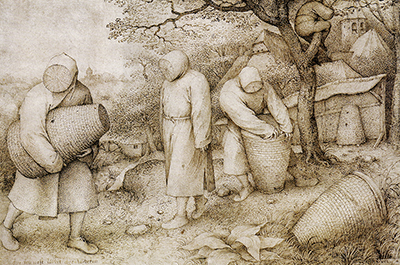Pieter Bruegel completed this pen and indian ink drawing in 1568 and it remains one of his finest contributions within this medium.
The Beekeepers and the Birdnester can be found at the Staatliche Museen in Berlin and displays the artist's common routine of depicting the daily lives of local people. There is more to the content than initially meets the eye here, with honey itself representing an important part of the poor's diet at this time in Netherlandish regions and also being viewed as a pure, natural product. The artist used bees nests in other drawings and paintings to continue this symbolism, in some cases even representing the conflict between different strands of the Christian Church (see an engraving titled Hope).
There is a strange, sinister appearance to this particuar drawing due to the very nature of the Beekeepers outfits - flat hoods replace the facial expressions, giving us the form of humanity but without the faces and personality to go with it. Without the ability to identify those behind the masks, this leaves an uncomfortable feeling that surely was deliberately created. Compare this to Bruegel's expressive paintings such as Netherlandish Proverbs, The Harvesters or Peasant Dance where individual characteristics are delivered, even celebrated.
Bee keeping is a discipline many thousands of years old, even at that time, but it held a particular importance to the poor because of how it could be done on land that was unsuitable for other crops. The more arable land would be purchased by richer farmers and used for other products as a result. This also helped to keep the cost of honey down and make it more accessible to different levels of society. At this stage there were also improvements needed in the production of sugar, meaning honey was essential as a sweetener for many years to come.




